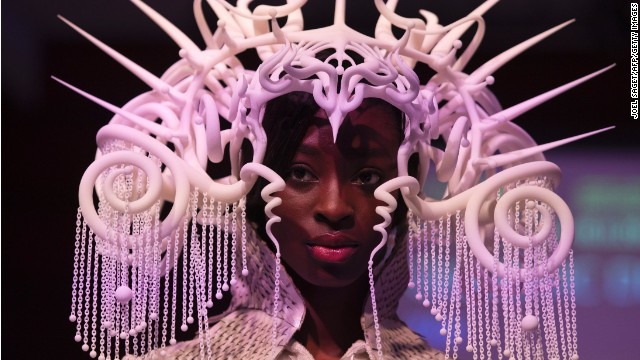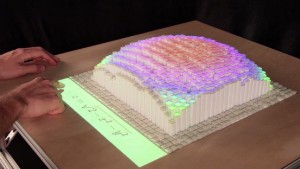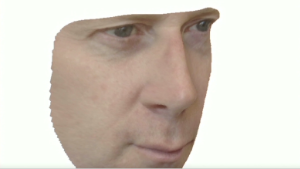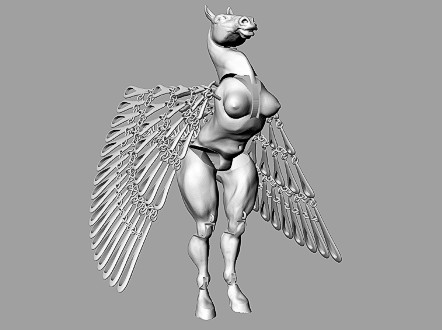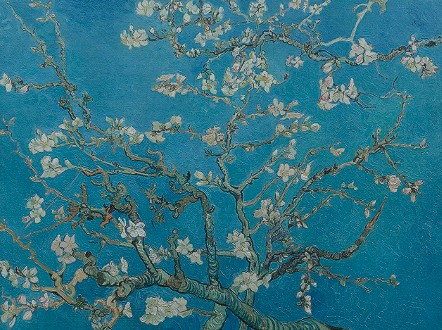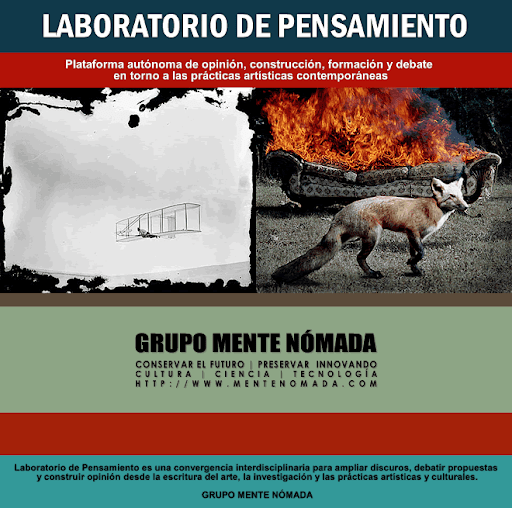ORIGINAL: The Guardian (Nov 17),
EDGE (Dic 16)

News From:
The Observer—The New Review
Read the full article →
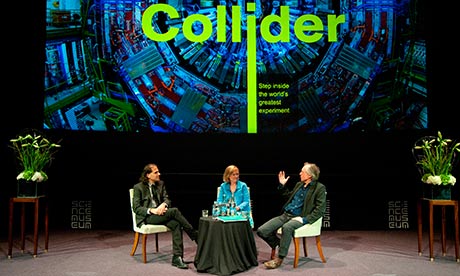 |
Nima Arkani-Hamed, Martha Kearney and Ian McEwan at London's Science Museum
Photograph: Jennie Hills/Science Museum |
DO THE TWO CULTURES STILL EXIST?
IAN McEWAN: That old, two-culture matter is still with us, ever since
[CP] Snow promulgated it back in the 50s. It still is possible to be a flourishing, public intellectual with absolutely no reference to science but it's happening less and less. And I think it's less a change of any decision in the culture at large, just a social reality pressing in on us. And it's true that climate change forces us to at least get a smattering of some idea of what it is to predict systems that have more than two or three variables and whether this is even possible. The internet has created sites like
John Brockman's wonderful
edge.org, where it's possible for laymen to sit in on conversations between scientists. And when scientists have to address each other out of their specialisms they have to speak plain English, they have to abandon their jargons, and we're the beneficiaries of that.
NIMA ARKANI-HAMED: It's an asymmetry that doesn't really need to exist. Certainly many scientists are very appreciative of the arts. The essential gulf is one of language and especially in theoretical
physics, the basic difficulty is that most people don't understand our language of mathematics which we use to describe everything we know about the universe. And so while I'm capable of listening to and intensely enjoying a
Beethoven sonata or an
Ian McEwan novel it can be more difficult for people in the arts to have some appreciation for what we do. But at a deeper level there's a commonality between certain parts of the arts and certain parts of the sciences.
IM: I'm one of those know-nothing liberal arts students who at the age of 16 remembers a maths teacher coming into the room and saying "
I'll take 10 of you volunteers and I'll get you through A-level maths" so us English, history, French types went and were patiently taken through and it was the most intellectually difficult and delightful thing I ever did. And the highest I got was calculus. I thought I had reached my intellectual ceiling. Now that's first steps for any maths undergraduate but it gave me a taste for the sort of respect for a society where you couldn't really claim to be any sort of intellectual unless you had some kind of foot in the world of mathematics. So I think we're in a situation of awkward respect. You go into
Westminster Abbey and
Dirac's equation is carved in stone. To stand there and look at it, I think even for those of us who've got very little grasp of maths, can be a kind of aesthetic experience.
NA-H: One of the things that we try to do sometimes in explaining what's going on in physics is to find useful analogies and metaphors. But we could be doing a better job explaining the structure in which we're having these thoughts, explaining why we're doing what we're doing, explaining the pursuit of truth with a capital T which is underlying all of it: what it is that motivates people to spend three decades working with not necessarily a payoff in sight until, every now and then, we celebrate these tremendous achievements. There is an obsessive element to it which should be familiar to the artist – to many people in society. And it's driven by the pursuit of something much, much bigger than ourselves and the little trivial concerns of everyday life.
SCIENCE, ART AND THE IDEA OF BEAUTY
NA-H: There's a very common metaphor for describing the
Higg's particle. It's this idea of the universe filled with something and the little ball bearing or whatever it was passing through the fluid picking up some inertia. That's a good example of a metaphor that gives some sense of what's actually going on. There's a difficulty with metaphors, which is that you can't take them too far – they're not literally what's going on. And often when that analogy is used there's some clever person in the audience, normally a 12-year-old kid, who puts up their hand and says
"Excuse me, isn't that just like the ether? Didn't you guys learn anything?" And that's when we have to say: "
Trust us. It's something that fills the universe that's not like the ether" and so there's always a limitation to metaphors. It is possible to explain some of these things. This is one of the wonderful things about fundamental physics. The essential ideas are simple. The possible answers to essential open questions are more complicated but the essential issues are deep and they're simple to state. And with some patience it's possible to address them head on and get a sense for what's going on without all the details of the mathematics. But it requires a very engaged audience and it can't be done casually.
IM: Nima has written a stunning essay for the layman called
The Future of Fundamental Physics. There's not a line of maths in it. I'm not going to pretend it's easy reading but you wrote it, I think, for anyone who's interested in that question, outside the field. I think we've lived through a golden age of science writing. Natural selection is not a very difficult idea but its consequences cascade beautifully.
Bayes' Theorem is not very difficult, I mean it's almost arithmetic and yet the applications it now has in neuroscience are formidable. So I think we can cross these fields together and I'm very interested in the aesthetics of this. There's that famous remark of
Jim Watson's, when
Rosalind Franklin came to look at his and Crick's model of a DNA molecule, that it was too beautiful not to be true. Again we come into this field in which the aesthetics of something in the
Keatsian sense – beautiful and true – must embrace both subjects.
NA-H: We often talk of the idea of beauty in theories. And I think if this is interpreted loosely you won't get really a sense of what we mean. We have to be a little more specific. Ideas that we find beautiful are not a capricious aesthetic judgment. It's not fashion, it's not sociology. It's not something that you might find beautiful today but won't find beautiful 10 years from now. The things that we find beautiful today we suspect would be beautiful for all eternity. And the reason is, what we mean by beauty is really a shorthand for something else. The laws that we find describe nature somehow have a sense of inevitability about them. There are very few principles and there's no possible other way they could work once you understand them deeply enough. So that's what we mean when we say ideas are beautiful. A year ago I ran into this
great lecture on YouTube by Leonard Bernstein about the first movement of
Beethoven's Fifth. And Bernstein used precisely this language – not approximately this language – exactly this language of inevitability, perfect accordance to its internal logical structure and how difficult and tortuous it was for Beethoven to figure out. He used precisely the same language we use in mathematics and theoretical physics to describe our sense of aesthetics and beauty.
IM: You don't hear beauty much mentioned even by composers in relation to modern music. It's not the common pursuit. For my taste all atonal music sounds like an expression of anxiety. And yet I think we do need a return to this in the arts. I don't think we have much trouble in poetry with this.
Seamus Heaney died recently and there was a lot of time to reflect on his work, and the beauty of those lines, of his work was constantly referenced. Part of the problem was modernism, the great aesthetic revolution of the early 20th century to which we are all bound and must work in gratitude for – but we lost certain things. Along the way emotion and art were somewhat detached. When I was a student at
Sussex University we had to write essays on a statement by the
Spanish philosopher Ortega y Gasset in which he said "
tears and laughter are aesthetic frauds". This was the pure, high, modernist statement, that you had to detach those feelings about emotion and beauty from art itself.
THE DAILY LIVES OF ARTISTS AND SCIENTISTS
IM: I often wonder what theoretical physicists do all day and my fantasy is they are rather like novelists. They sit around with their feet on the radiator staring out the window with a notepad within reach. They must be in the world of that kind of misty, drifting, creative thinking that has a bit of talent, a bit of luck, a bit of being shaped by current mood that can bring sudden insight. To wonder how to progress or even start a novel is to enter a state of what
V S Pritchett called determined stupor, and those of us who are paid to be in that state count ourselves very lucky.
NA-H: I've always thought composers and novelists are probably very close to mathematicians and theoretical physicists psychologically in how they go about things.
Perhaps contrary to a certain sort of mythology people don't go to their offices and just churn through equations. You have a certain set of questions you are trying to solve and you have to imagine what the story could possibly be for what the solution is. You have to try to imagine what the sort of global answer could possibly look like – or at least chunks of the global answer. You try on stories – could it work like that? And often because of the underlying rigidity, the same thing that gives rise to the beauty that we talked about, it's beauty because there is a right and wrong. There is some problem that's being solved. If the story is a great story it has a better chance of being right than if it's a crappy story. And sometimes stories are too good to be true and that happens very often. And we try out what could possibly be solutions to the problems and then we have to prove ourselves wrong as quickly as we possibly can. And that's what 99% of our life is about. We try out stories and we prove them wrong. So you have this experience of failing day after day after day and it's a particularly intensely bad feeling to fail so much because you know what success looks like and you can't fool yourself when you're not there. So even though you don't know what the solution is, you know when you don't have it. You have to keep going and going until gradually you fail better and better and better and every now and then, once every two or three years, something works.
IM: Here is a major difference. I'm well aware in science how important it is to be first. Being second with the structure of DNA would consign you to the dustbin of history, whereas every novelist knows that you're in a self-sustaining world in which whatever you say is so. It's for others to accept it or reject it. I often pity those scientists who are in a race just to get on the public record for the first time – days, weeks before someone else – and your life can be transformed. Crick and Watson are a perfect case of this. If [
Linus] Pauling had got there before them we wouldn't have heard of Jim Watson. It's a tougher world.
NA-H: It's one of the classic things we talk about, the difference between art and science. Even here there's more commonality than meets the eye. But I want to say one thing about originality at an even baser level of how easy it is to be original, how much innate, intrinsic talent is needed to be able to do something. And here we [scientists] have an advantage – there's this thing out there that we're not inventing but discovering. And because of that all you have to do is get somewhere in the neighbourhood of the truth. You don't have to get particularly close to it, you just have to know that it's there and then you have to not fight it and just let it drag you in toward itself. If you're very talented you might hack your way there more quickly. If you're less talented you might have to pinball around and it takes a little longer to get there.
IM: That fateful morning when one of his children was extremely ill and Darwin opened a 20-page letter from
[Alfred Russel] Wallace and said "
All my originality is smashed". The anxiety attack that Darwin had then, no novelist could have such a thing.
NA-H: What you're talking about – the anxiety, who gets the credit and so on – this is important to the individuals involved. It's of no importance in the grand scheme of things. But there is an important sense in which even the same discoveries, even the same existing body of knowledge, the things that are sitting there in textbooks for hundreds of years already, are perceived in different ways by different scientists. Because to be able to do anything new you have to organise the existing body of knowledge in some unique way that's your way of thinking about it. One of the deeper reasons why it's important to have different people approaching the same problem – even if they end up finding the same solution – is the path towards a solution suggests many divergent ways things could progress and having many of those paths is still useful.
IM: Writing a novel takes roughly about the time of an undergraduate course for me and you might draw on the work of a historian, you might need to read a biography of a composer. I would like to feel that we could think about science as just one more aspect of organised human curiosity rather than as a special compartment. And it has, as has been very clear from this discussion, a powerful aesthetic. I think we need to generalise it. We need to absorb it into our sense that we can love the music of Beethoven without being composers and we could love science as a celebration of human ingenuity without being scientists.
Science has had a huge effect on my own sense of the world. It certainly has helped me along the way to a general global scepticism about religion. The world of faith is inimical to the world of science and in that sense science has helped me want to write books every now and then that celebrate a full-blooded rationalism. It's one of our delightful aspects and it informs what we try to do with our laws and social policy. We don't succeed a lot of the time. And we despair of human relationships at the most private level when they're irregular or contradictory. We demand even of our lovers a degree of coherence and behind that lies a notion of consistency and rationality.
Enduring Love was actually a novel wishing to oppose the romantic notion that abstraction and logic and rationality and science in particular was a cold-hearted thing, a myth I think which began with
Mary Shelley's Frankenstein. We need to reclaim our own sense of the full-bloodedness, the warmth of what's rational.
[EDITOR'S NOTE: Related reading on Edge:
"The Third Culture", 1991]
